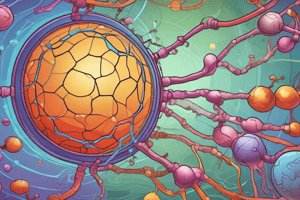Podcast
Questions and Answers
What is the primary role of ATP in cells?
What is the primary role of ATP in cells?
- To transport oxygen in the blood
- To synthesize proteins
- To store genetic information
- To serve as an energy currency (correct)
Which process specifically requires ATP for active transport?
Which process specifically requires ATP for active transport?
- Transmitting signals between neurons
- Generating heat during metabolism
- Moving substances along a concentration gradient (correct)
- Facilitating diffusion across membranes
ATP is a derivative of which type of biomolecule?
ATP is a derivative of which type of biomolecule?
- Nucleic acids (correct)
- Lipids
- Carbohydrates
- Proteins
What components are present in ATP?
What components are present in ATP?
Which type of respiration requires oxygen to generate ATP?
Which type of respiration requires oxygen to generate ATP?
How do plants primarily produce ATP during cellular respiration?
How do plants primarily produce ATP during cellular respiration?
What sugar component of ATP is crucial for its structure?
What sugar component of ATP is crucial for its structure?
Which of the following organisms also require ATP?
Which of the following organisms also require ATP?
What is the primary role of ATP in cellular processes?
What is the primary role of ATP in cellular processes?
What happens to ATP when it is hydrolyzed?
What happens to ATP when it is hydrolyzed?
Why is the bond between the second and third phosphates in ATP considered unstable?
Why is the bond between the second and third phosphates in ATP considered unstable?
How does the energy from ATP hydrolysis become useful to a cell?
How does the energy from ATP hydrolysis become useful to a cell?
What does it mean when a protein is phosphorylated?
What does it mean when a protein is phosphorylated?
In what type of transport is ATP typically utilized?
In what type of transport is ATP typically utilized?
Which analogy is used to explain how ATP behaves during energy release?
Which analogy is used to explain how ATP behaves during energy release?
What characteristic of ATP allows it to quickly provide energy to cells?
What characteristic of ATP allows it to quickly provide energy to cells?
Flashcards
ATP
ATP
Adenosine triphosphate, a nucleotide derivative crucial for cellular processes.
ATP Function
ATP Function
ATP powers many cellular processes, such as active transport, muscle contraction, and cell signaling.
ATP Structure
ATP Structure
ATP consists of adenine, ribose sugar, and three phosphate groups.
ATP Production Processes
ATP Production Processes
Signup and view all the flashcards
Cellular Respiration (Plants)
Cellular Respiration (Plants)
Signup and view all the flashcards
Cellular Respiration (Animals)
Cellular Respiration (Animals)
Signup and view all the flashcards
Roles of ATP
Roles of ATP
Signup and view all the flashcards
Nucleotide derivative
Nucleotide derivative
Signup and view all the flashcards
ATP Cycle
ATP Cycle
Signup and view all the flashcards
ATP Hydrolysis
ATP Hydrolysis
Signup and view all the flashcards
ADP
ADP
Signup and view all the flashcards
Exergonic Reaction
Exergonic Reaction
Signup and view all the flashcards
Phosphorylation
Phosphorylation
Signup and view all the flashcards
Active Transport
Active Transport
Signup and view all the flashcards
Cellular Respiration
Cellular Respiration
Signup and view all the flashcards
ATP Instability
ATP Instability
Signup and view all the flashcards
Study Notes
ATP: The Cellular Energy Currency
- ATP (adenosine triphosphate) is a crucial molecule for cellular processes
- Often depicted as a starburst or thunderbolt, ATP is an energy currency
- ATP is a nucleotide derivative, similar to DNA and RNA
- ATP has three phosphate groups, a ribose sugar, and an adenine base
- Cellular processes, like active transport and muscle contraction, require ATP
ATP Functions
- ATP powers many cellular processes, including active transport (moving molecules against concentration gradients) and muscle contraction (actin-myosin interaction)
- Important for a variety of cell signaling (how cells communicate)
ATP Production
- ATP production varies in different cells
- Cells may use aerobic cellular respiration or anaerobic respiration, depending on the presence of oxygen
- Plants use photosynthesis to produce glucose, used during cellular respiration to synthesize ATP
- Animals consume glucose from food for the production of ATP during cellular respiration
ATP Cycle
- ATP can be hydrolyzed (broken down) to release energy
- A phosphate group is removed, converting ATP to ADP (adenosine diphosphate)
- Cellular respiration provides the energy required to add a phosphate to ADP, resynthesizing ATP
ATP in Cellular Transport
- ATP powers active transport, enabling movement of molecules against concentration gradients
- ATP phosphorylation (adding a phosphate) changes a protein shape which facilitates movement, crucial for processes like cell transport, movement of chromosomes and binding amino acids to tRNA
- The phosphate is transferred to a transport protein, creating an energized state of the protein that moves the molecules against the gradient
Studying That Suits You
Use AI to generate personalized quizzes and flashcards to suit your learning preferences.



